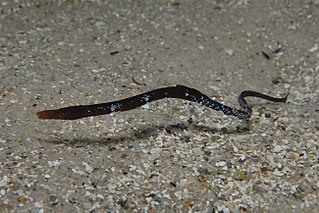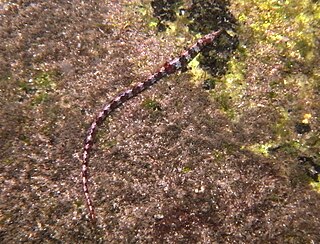
The beady pipefish is a species of pipefish of the family Syngnathidae. It is found in the Indo-West Pacific, from the western Persian Gulf, to the north central Indian Ocean, to Japan and Australia. It lives in the lower parts of streams and rivers, estuarine habitats such as seagrass beds and mangroves, and shallow inshore habitats, where it can grow to lengths of 16–18 centimetres (6.3–7.1 in). It is expected to feed on small crustaceans, similar to other pipefish. This species is ovoviviparous, with males carrying eggs in a brood pouch before giving birth to live young. Average brood size is 177.
Lissocampus bannwarthi is a species of marine pipefish belonging to the family Syngnathidae.

Histiogamphelus briggsii, also known as Brigg's pipefish, is a species of marine fish in the family Sygnathidae. It can be found in the shallow waters surrounding South Australia, New South Wales, and Northern Tasmania. Its habitat can consist of reefs, seagrass beds, and sandy beach and estuarine environments Individuals of this species can grow to lengths of 25 cm (9.8 in). They are an ovoviviparous species, in which males brood eggs and give birth to live young.

Histiogamphelus cristatus, known as Macleay's crested pipefish or rhino pipefish, is a species of marine fish belonging to the family Sygnathidae. This species can be found in a variety of marine habitats such as seagrass beds, sandy ocean bottoms, and estuaries, surrounding south and southwestern Australia. Their main source of food are small crustaceans found in the water column or in sediments. Males of the species brood eggs and give birth to live offspring.
Hypselognathus horridus, known commonly as the prickly pipefish or shaggy pipefish is a species of marine fish belonging to the family Sygnathidae This species lives on the continental shelf in depths ranging from 40 to 55 m. It is endemic to the Great Australian Bight, located in South Australia. Reproduction occurs through ovoviviparity in which the males brood eggs and give birth to live young

Ichthyocampus carce, also known as the freshwater pipefish or Indian freshwater pipefish is a species of marine fish belonging to the family Syngnathidae. It can be found mainly in freshwater streams, rivers, and estuaries located in the Indian Ocean and West Pacific, from Indonesia to the western coast of India. It can live in both inland and coastal waters. This species can grow to a length of 15cm and feeds primarily on small invertebrates and zooplankton. Reproduction occurs through ovoviviparity, in which the males carry eggs in a brood pouch before giving live birth. Males of this species can brood roughly 280 offspring at a time.
Hypselognathus rostratus, also known as the knife-snouted pipefish is a species of marine fish belonging to the family Syngnathidae. This species can be found in very shallow coastal waters of southeastern Australia. Their habitat consists of sandy substrates, seagrass beds, and estuaries. Reproduction occurs through ovoviviparity in which the males brood eggs before giving live birth.
Lissocampus fatiloquus, also known as prophet's pipefish is a species of marine fish belonging to the family Syngnathidae. The species has been noted in a variety of habitats including sargassum, seagrass beds and sandy substrates along the coast of Western Australia from Shark Bay to Rottnest Island. Their diet is thought to consist of small crustaceans such as copepods. Reproduction occurs through ovoviviparity in which the males brood eggs before giving live birth.

Lissocampus runa, also known as the javelin pipefish is a species of marine fish belonging to the family Syngnathidae. This species can be found in algae beds, rocky reefs, tidepools, and estuaries along the coast of southern Australia from Broken Head Nature Reserve in New South Wales to Rottnest Island, Western Australia. Their diet is thought to consist of small crustaceans such as copepods. Reproduction occurs through ovoviviparity in which the males brood eggs before giving live birth.
Phoxocampus diacanthus, also known as the obscure pipefish or spined pipefish, is a species of marine fish belonging to the family Sygnathidae. It can be found inhabiting reefs throughout the Indo-Pacific from Japan and Sri Lanka to Samoa and New Caledonia in the south. Its diet likely consists of small crustaceans. Reproduction occurs through ovoviviparity in which the males brood eggs before giving live birth.
Stigmatopora nigra, also known as the wide-bodied pipefish is a species of marine fish belonging to the family Syngnathidae. This species can be found in the shallow waters, bays, and estuaries of southern Australia from Shark Bay to Brisbane, Tasmania, and New Zealand. They often inhabit seagrass or algae beds in addition to bare sand. Their diet consists of small crustaceans such as copepods and amphipods. Adult brooding males have been measured at 6.5-7 centimeters. Reproduction occurs through ovoviviparity. in which the males brood up to 25 eggs in a pouch below the tail before giving live birth. Stigmatopora nigra can live to 150 days old and are able to reproduce throughout the year.
Urocampus carinirostris, also known as the hairy pipefish, is a species of marine fish belonging to the family Syngnathidae. They can be found inhabiting shallow seagrass beds and estuaries in Papua New Guinea and along the southern coast of Australia from Queensland to Swan River, Western Australia. Urocampus carinirostris is an ambush predator that is most commonly found on the edges of protected seagrass beds and near mangrove. Its diet consists of copepods and other small crustaceans. Reproduction occurs through ovoviviparity in which males brood around 48 eggs in a pouch beneath their tail before giving live birth to fully formed offspring. Adults can breed for at least six months.

Trachyrhamphus bicoarctatus, also known as the double-ended pipefish is a species of marine fish belonging to the family Syngnathidae. They can be found in reefs, seagrass beds, and sandy habitats throughout the Indo-Pacific from East Africa to New Caledonia and from Japan to Australia. Males of this species are considered mature when they reach approximately 26 centimeters long, but adults can grow to be lengths of 40 centimeters. Reproduction occurs through ovoviviparity in which males brood eggs before giving live birth.
Trachyrhamphus longirostris, also known as the long-head pipefish or straightstick pipefish, is a species of marine fish belonging to the family Syngnathidae. They can be found in muddy estuaries on the continental shelf throughout the Indo-Pacific from Eastern Africa to the Solomon Islands and Japan. The diet of Trachyrhamphus longirostris likely consists of small crustaceans. Adult individuals can grow to be approximately 33 centimeters in length. Reproduction occurs through ovoviviparity in which males brood eggs before giving live birth.
Nannocampus pictus, also known as the reef pipefish is a species of marine fish belonging to the family Syngnathidae. They can be found inhabiting reefs and seagrass beds of the western Indian Ocean and the eastern coast of Australia including the Great Barrier Reef. Members of this species can grow to lengths of 10 cm and their diet likely consists of small crustaceans such as copepods. Reproduction occurs through ovoviviparity in which the males brood eggs before giving live birth.
Nannocampus subosseus, also known as the bony-headed pipefish is a species of marine fish belonging to the family Syngnathidae. They can be found inhabiting reefs and tide pools only in the region of Shark Bay to Esperance, Western Australia. Members of this species can grow to lengths of 12 cm and their diet likely consists of small crustaceans such as copepods. Reproduction occurs through ovoviviparity in which the males brood eggs before giving live birth.
Vanacampus margaritifer, also known as the mother-of-pearl pipefish is a species of marine fish belonging to the family Syngnathidae. They can be found inhabiting seaweed and seagrass beds in addition to rocky reefs along the southern and eastern coast of Australia from Brisbane to Perth. Their diet likely consists of small crustaceans. Reproduction occurs through ovoviviparity in which the males brood eggs before giving live birth.

Vanacampus vercoi, also known as Verco's pipefish is a species of marine fish belonging to the family Syngnathidae. They can be found inhabiting seaweed and seagrass beds in addition to tidepools at depths between 2–4 meters from Spencer's Gulf to Encounter Bay, South Australia. Their diet likely consists of small crustaceans such as amphipods and copepods. Reproduction occurs through ovoviviparity in which the males brood eggs before giving live birth.

Vanacampus poecilolaemus, also known as the Australian long-nosed pipefish is a species of marine fish belonging to the family Syngnathidae. They can be found inhabiting seaweed and seagrass beds of estuaries along the southern coast of Australia including the northern coast of Tasmania. Their diet likely consists of small crustaceans such as mysid shrimps. Adults of this species can reach up to 30 cm in length. Reproduction occurs through ovoviviparity in which the males brood eggs before giving live birth to roughly 40-50 offspring.

Vanacampus phillipi, also known as the Port Phillip pipefish is a species of marine fish belonging to the family Syngnathidae. They can be found inhabiting seaweed and seagrass beds along the southern coast of Australia from Perth to Jervis Bay, New South Wales including the coast of Tasmania. Their diet consists of small crustaceans such as copepods, amphipods, and mysid shrimps. Reproduction occurs through ovoviviparity in which the males brood eggs before giving live birth to 50 or less offspring.










